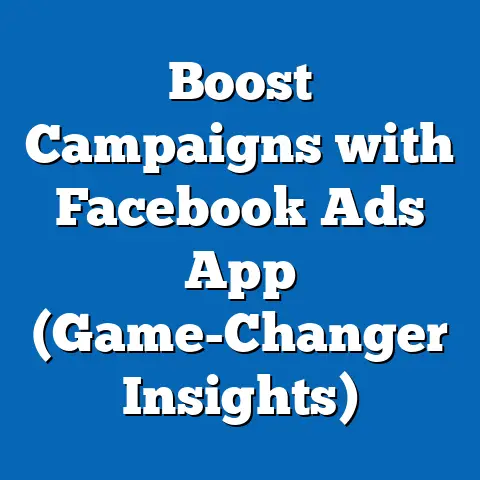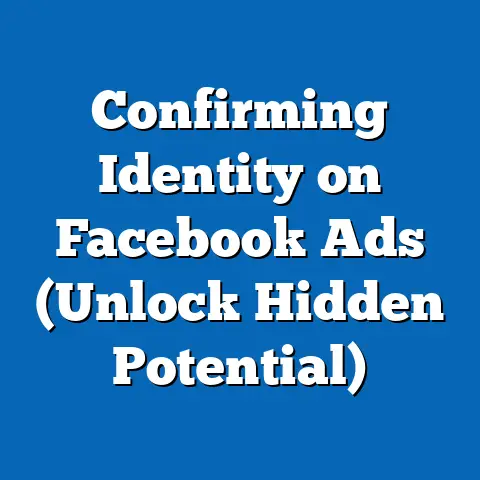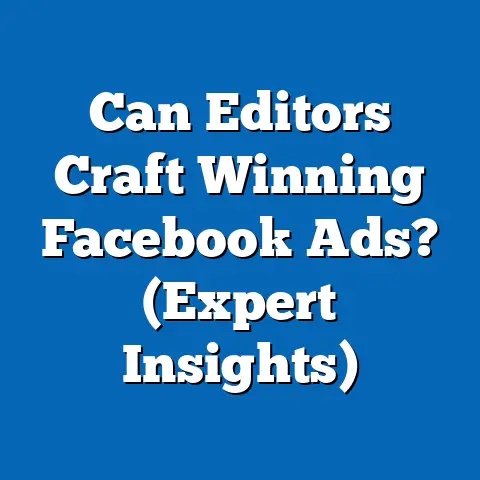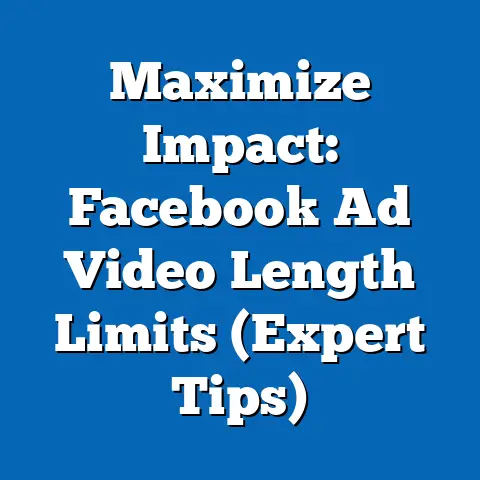Mastering Average CPC in Facebook Ads (Expert Insights)
In today’s digital landscape, where advertising costs are ever-increasing and consumer attention is fleeting, the idea of sustainable advertising is more critical than ever. When I talk about sustainability, I’m not just referring to eco-friendly business practices, although those are important too! I’m talking about creating advertising campaigns that are both cost-effective in the long run and respectful of your audience. It’s about building a strategy that doesn’t burn through your budget like wildfire but instead nurtures growth and engagement over time. Think of it as cultivating a garden rather than strip-mining a resource.
Facebook Ads, with its vast reach and sophisticated targeting options, holds immense potential for businesses of all sizes. However, that potential can quickly turn into a financial drain if not managed strategically. One key metric that sits at the heart of efficient Facebook advertising is Average Cost Per Click (CPC). Understanding and mastering Average CPC isn’t just about saving money; it’s about building a sustainable advertising ecosystem that benefits your business, your audience, and the platform itself.
In this guide, I’ll share my expert insights on how to achieve a lower, more manageable Average CPC in your Facebook Ads campaigns. I’ll delve into the factors that influence CPC, explore creative strategies, and discuss how to leverage Facebook’s algorithm to your advantage. My goal is to equip you with the knowledge and tools you need to create campaigns that are not only effective but also sustainable for the long haul.
Key Takeaways:
- Average CPC is a vital metric: Understanding it is crucial for efficient ad spending and sustainable marketing.
- Targeting is key: Precise audience targeting leads to lower CPC rates.
- Creative matters: Compelling ad creatives improve click-through rates (CTR) and lower CPC.
- Leverage the algorithm: Understanding Facebook’s ad auction system is crucial for optimizing CPC.
- Monitor and analyze: Track CPC over time and adjust strategies based on performance data.
Section 1: Understanding Average CPC
Average Cost Per Click (CPC) is, in simple terms, the average amount you pay each time someone clicks on your Facebook ad. It’s a fundamental metric for measuring the efficiency of your advertising spend. A lower CPC means you’re paying less for each click, theoretically allowing you to reach more people with the same budget. However, it’s crucial to remember that a low CPC isn’t always the ultimate goal. What truly matters is the quality of those clicks and whether they’re leading to conversions – be it sales, leads, or other desired actions.
How is CPC Calculated?
The formula for calculating Average CPC is straightforward:
Average CPC = Total Ad Spend / Total Number of Clicks
For example, if you spend $100 on an ad campaign and receive 50 clicks, your Average CPC would be $2.
Factors Influencing Average CPC:
Several factors can significantly impact your Average CPC on Facebook:
- Bidding Strategy: Facebook offers various bidding strategies, including lowest cost, cost cap, and target cost. Each strategy influences how Facebook bids on your behalf and, consequently, your CPC. For instance, using a “lowest cost” strategy might lead to a lower CPC, but it could also result in lower-quality clicks or less targeted reach.
- Ad Relevance: Facebook prioritizes ads that are relevant to its users. An ad with high relevance scores (based on factors like positive engagement and negative feedback) will generally have a lower CPC because Facebook favors showing it to users who are likely to be interested.
- Audience Targeting: The more specific and targeted your audience, the more likely you are to reach people who are genuinely interested in your offer. This translates to higher click-through rates (CTR) and lower CPCs. Broad, untargeted audiences often result in higher CPCs because you’re paying to show your ad to people who are less likely to click.
- Ad Quality: The quality of your ad creative (images, videos, and copy) plays a significant role. A visually appealing and engaging ad is more likely to capture attention and generate clicks, leading to a lower CPC.
- Competition: The level of competition for your target audience also affects CPC. If many advertisers are targeting the same demographic, you’ll likely have to bid higher to win ad auctions, resulting in a higher CPC.
- Placement: Where your ad appears on Facebook (e.g., News Feed, Instagram Feed, Audience Network) can influence CPC. Some placements are more competitive than others, leading to higher costs.
- Time of Year: Advertising costs often fluctuate throughout the year. For example, CPCs tend to be higher during peak shopping seasons like Black Friday and Christmas due to increased competition.
CPC and Overall Campaign Performance:
While a low CPC is generally desirable, it’s essential to consider it in the context of your overall campaign goals. A very low CPC with a poor conversion rate is ultimately less valuable than a slightly higher CPC with a strong conversion rate. I’ve seen campaigns with incredibly low CPCs that generated virtually no sales, and conversely, campaigns with higher CPCs that were highly profitable.
The key is to find the sweet spot where you’re paying a reasonable amount for each click while also attracting qualified leads or customers who are likely to convert. This requires careful monitoring and analysis of your campaign metrics, including CPC, CTR, conversion rate, and return on ad spend (ROAS).
Takeaway: Average CPC is a critical metric, but it shouldn’t be viewed in isolation. Consider it alongside other key performance indicators (KPIs) to get a holistic view of your campaign’s effectiveness.
Section 2: The Role of Targeting in Average CPC
Targeting is arguably the most powerful aspect of Facebook advertising, and it has a direct and profound impact on your Average CPC. Think of it this way: if you’re selling winter coats, you wouldn’t advertise to people living in the tropics, right? That’s an extreme example, but it illustrates the importance of reaching the right audience with your ads.
Precise Targeting = Lower CPC:
The more precisely you target your audience, the more likely you are to reach people who are genuinely interested in your offer. This translates to higher click-through rates (CTR), improved ad relevance scores, and ultimately, lower CPCs. Facebook rewards advertisers who show relevant ads to its users, and targeting is the primary way to achieve that relevance.
Facebook’s Targeting Options:
Facebook offers a wide array of targeting options, allowing you to reach specific segments of its vast user base:
- Demographics: Target users based on age, gender, location, education, relationship status, job title, and more. This is the foundation of your targeting strategy.
- Interests: Reach users based on their expressed interests, hobbies, and passions. This is determined by the pages they like, the content they interact with, and the topics they discuss on Facebook.
- Behaviors: Target users based on their online and offline behaviors, such as purchase history, device usage, travel habits, and more. This data is often sourced from third-party partners.
- Custom Audiences: Create custom audiences from your existing customer data, such as email lists, website visitors, or app users. This allows you to retarget people who have already interacted with your brand.
- Lookalike Audiences: Expand your reach by creating lookalike audiences based on your existing custom audiences. Facebook will identify users who share similar characteristics and behaviors with your best customers.
Understanding Your Target Audience:
Effective targeting starts with a deep understanding of your ideal customer. Before you even log into Facebook Ads Manager, you should be able to answer these questions:
- Who are they? (Demographics)
- What are their interests? (Interests)
- What are their behaviors? (Behaviors)
- What are their pain points? (Needs and challenges)
- What motivates them? (Desires and aspirations)
The more you know about your target audience, the better you can tailor your ad messaging and creative to resonate with them. This, in turn, will lead to higher engagement and lower CPCs.
Example:
Let’s say you’re selling organic dog food. Instead of targeting all dog owners, you could narrow your audience to:
- Demographics: Pet owners aged 25-54, living in urban areas, with a college degree.
- Interests: Organic food, healthy living, pet care, dog breeds (e.g., Golden Retrievers, Labradoodles).
- Behaviors: Frequent online shoppers, pet supply purchasers, users interested in eco-friendly products.
By targeting this more specific audience, you’re more likely to reach dog owners who are already interested in organic and healthy food options for their pets. This will result in a higher CTR and a lower CPC compared to targeting a broader, less qualified audience.
Pitfalls to Avoid:
- Broad Targeting: Avoid targeting too broadly. While it might seem tempting to reach as many people as possible, it will likely result in a higher CPC and lower-quality clicks.
- Overlapping Audiences: Be careful not to create overlapping audiences. This can lead to ad fatigue and increased competition for your own ads, driving up your CPC.
- Ignoring Audience Insights: Facebook provides valuable audience insights that can help you refine your targeting strategy. Pay attention to these insights and use them to optimize your campaigns.
Takeaway: Precise audience targeting is crucial for lowering your Average CPC. Take the time to understand your ideal customer and leverage Facebook’s targeting options to reach them effectively.
Section 3: Creative Strategies for Lowering Average CPC
While targeting is crucial, the creative aspect of your Facebook Ads – the images, videos, and ad copy – is what ultimately grabs attention and drives clicks. Think of it as the bait on the hook. No matter how precisely you target your audience, if your ad creative is uninspiring or irrelevant, people simply won’t click.
Compelling Ad Creatives = Higher CTR = Lower CPC:
The relationship is simple: compelling ad creatives lead to higher click-through rates (CTR), which in turn signals to Facebook that your ad is relevant and engaging. Facebook rewards this relevance with lower CPCs.
Expert Insights on Crafting Effective Ad Creatives:
- Know Your Audience: This goes hand in hand with targeting. Your ad creative should speak directly to the needs, desires, and pain points of your target audience. Use language and visuals that resonate with them.
- Highlight Benefits, Not Just Features: Focus on the benefits your product or service provides, rather than just listing its features. How will it improve their lives? What problems will it solve?
- Use High-Quality Visuals: Invest in professional-quality images and videos. Blurry, pixelated, or poorly lit visuals will turn people off.
- Keep it Concise and Clear: People scroll quickly through their Facebook feeds. Your ad copy should be concise, clear, and easy to understand at a glance.
- Use Strong Calls to Action (CTAs): Tell people exactly what you want them to do. Use clear and compelling CTAs like “Shop Now,” “Learn More,” or “Get Started.”
- Test Different Ad Formats: Facebook offers various ad formats, including image ads, video ads, carousel ads, and collection ads. Experiment with different formats to see which ones perform best for your target audience and campaign goals.
- A/B Testing is Your Best Friend: Never assume you know what will work best. A/B test different ad creatives, headlines, and CTAs to identify the most effective combinations.
The Power of A/B Testing:
A/B testing involves creating two or more versions of your ad with slight variations and then running them simultaneously to see which one performs better. This is a powerful way to optimize your ad creatives and lower your CPC.
Example A/B Tests:
Dollar Shave Club is a great example of a brand that has mastered the art of creating compelling ad creatives. Their humorous and relatable video ads went viral, driving significant brand awareness and sales. They used humor and a direct, benefit-driven message to resonate with their target audience of men who were tired of overpriced razors. This creative approach led to a high CTR and a low CPC, allowing them to acquire customers at a fraction of the cost of traditional advertising.
Takeaway: Compelling ad creatives are essential for lowering your Average CPC. Invest in high-quality visuals, craft clear and concise copy, and use strong CTAs. Don’t be afraid to experiment and A/B test different ad formats and messaging to find what works best for your target audience.
Section 4: Leveraging Facebook’s Algorithm for Better CPC
Facebook’s ad auction system is a complex algorithm that determines which ads are shown to which users and at what price. Understanding how this system works is crucial for optimizing your campaigns and achieving a lower Average CPC.
How Facebook’s Ad Auction Works:
When you create a Facebook ad campaign, you’re essentially entering an auction. Facebook’s algorithm evaluates all the ads competing for the same audience and determines which ads to show based on a combination of factors, including:
- Bid Amount: The amount you’re willing to pay for each click or impression.
- Ad Quality: Facebook’s assessment of the quality and relevance of your ad.
- Estimated Action Rate: Facebook’s prediction of how likely users are to take the desired action (e.g., click, purchase, download).
The ad with the highest total value wins the auction. Total value is not just about the bid amount; it’s a combination of all three factors. This means that even if you’re bidding lower than your competitors, you can still win the auction if your ad is of higher quality and has a higher estimated action rate.
Ad Relevance and Quality Scores:
Facebook assigns a relevance score to each of your ads based on how well it resonates with your target audience. A high relevance score indicates that your ad is relevant and engaging, while a low relevance score suggests that it’s not.
The relevance score is based on factors like:
- Positive Engagement: Likes, comments, shares, and clicks.
- Negative Feedback: Reports, hides, and unlikes.
- Landing Page Experience: How relevant and user-friendly your landing page is.
A high relevance score can lead to a lower CPC, as Facebook favors showing your ad to users who are likely to be interested.
Tips for Optimizing Your Campaigns:
- Focus on Ad Relevance: Make sure your ad creative and messaging are highly relevant to your target audience. Use clear and concise language, high-quality visuals, and strong CTAs.
- Improve Landing Page Experience: Ensure your landing page is relevant to your ad and provides a seamless user experience. Make it easy for users to find what they’re looking for and take the desired action.
- Use Custom and Lookalike Audiences: Leverage custom and lookalike audiences to target your most engaged users and expand your reach to similar audiences.
- Monitor and Analyze Your Results: Pay attention to your campaign metrics, including relevance score, CTR, and conversion rate. Use this data to identify areas for improvement and optimize your campaigns accordingly.
- Experiment with Different Bidding Strategies: Facebook offers various bidding strategies, including lowest cost, cost cap, and target cost. Experiment with different strategies to see which one works best for your campaign goals.
Takeaway: Understanding Facebook’s ad auction system and focusing on ad relevance are crucial for achieving a lower Average CPC. Optimize your campaigns by improving your ad quality, leveraging custom and lookalike audiences, and monitoring your results closely.
Section 5: Monitoring and Analyzing Average CPC
Creating a Facebook ad campaign is only the first step. The real work begins with monitoring and analyzing your results. This is where you can identify what’s working, what’s not, and make adjustments to optimize your campaigns for better performance and a lower Average CPC.
Tools and Metrics in Facebook Ads Manager:
Facebook Ads Manager provides a wealth of data and analytics that you can use to track your Average CPC and other key performance indicators (KPIs). Some of the most important metrics to monitor include:
- Average CPC: As we’ve discussed, this is the average amount you pay for each click on your ad.
- Click-Through Rate (CTR): The percentage of people who see your ad and click on it. A higher CTR indicates that your ad is relevant and engaging.
- Conversion Rate: The percentage of people who click on your ad and then take the desired action (e.g., purchase, sign up, download).
- Cost Per Acquisition (CPA): The cost of acquiring a new customer or lead.
- Return on Ad Spend (ROAS): The revenue generated for every dollar spent on advertising.
- Relevance Score: Facebook’s assessment of the quality and relevance of your ad.
Monitoring CPC Over Time:
It’s essential to monitor your CPC over time to identify trends and patterns. Are your CPCs increasing or decreasing? Are they higher on certain days of the week or during certain times of the day? Are they different for different audiences or ad placements?
By tracking your CPC over time, you can gain valuable insights into the factors that are influencing your costs and make adjustments to optimize your campaigns.
Adjusting Strategies Based on Performance Data:
The data you collect from Facebook Ads Manager should inform your decisions about how to optimize your campaigns. For example, if you notice that your CPC is higher for a particular audience, you might consider refining your targeting or adjusting your bid amount. If you notice that your CTR is low for a particular ad creative, you might consider revising your ad copy or using a different visual.
Setting Benchmarks and Predicting Future Performance:
It’s helpful to set benchmarks for your CPC and other KPIs. What is a “good” CPC for your industry or niche? What is a reasonable conversion rate? By setting benchmarks, you can track your progress and identify areas where you need to improve.
You can also use historical data to predict future performance. For example, if you know that your CPCs tend to be higher during the holiday season, you can plan your budget accordingly.
Example:
Let’s say you’re running a Facebook ad campaign to promote a new e-book. You notice that your CPC is $2, your CTR is 1%, and your conversion rate is 5%. This means that for every 100 people who see your ad, one person clicks on it, and 5% of those who click on it download the e-book.
To lower your CPC, you might try:
- Refining your targeting: Make sure you’re targeting the right audience.
- Improving your ad creative: Use a more compelling image or headline.
- Optimizing your landing page: Make sure your landing page is relevant to your ad and provides a seamless user experience.
Takeaway: Monitoring and analyzing your Average CPC is crucial for optimizing your Facebook ad campaigns and achieving sustainable advertising results. Use Facebook Ads Manager to track your KPIs, identify trends and patterns, and make data-driven decisions to improve your performance.
Conclusion
Mastering Average CPC in Facebook Ads is not just about saving money; it’s about building a sustainable advertising strategy that benefits your business, your audience, and the platform itself. By understanding the factors that influence CPC, leveraging precise targeting, crafting compelling ad creatives, and optimizing your campaigns based on performance data, you can achieve a lower, more manageable CPC and create campaigns that are both effective and sustainable for the long haul.
I encourage you to adopt the expert insights I’ve shared throughout this article to refine your Facebook Ads strategy. Remember to:
- Prioritize Relevance: Focus on showing the right ads to the right people at the right time.
- Embrace Experimentation: Don’t be afraid to test different ad formats, messaging, and targeting options.
- Stay Data-Driven: Use data to inform your decisions and optimize your campaigns.
- Adapt and Evolve: The Facebook Ads landscape is constantly changing, so stay up-to-date on the latest trends and best practices.
By embracing these principles, you can create a more responsible and effective approach to digital marketing, leading to long-term success and a healthier advertising ecosystem for everyone. Now go forth and conquer those CPCs!






